Yukgaejang is a flavorful Korean spicy beef and vegetable souppacked with shredded beef and hearty vegetables. This classic Korean soup is perfect for cold days, offering a comforting, spicy kick.
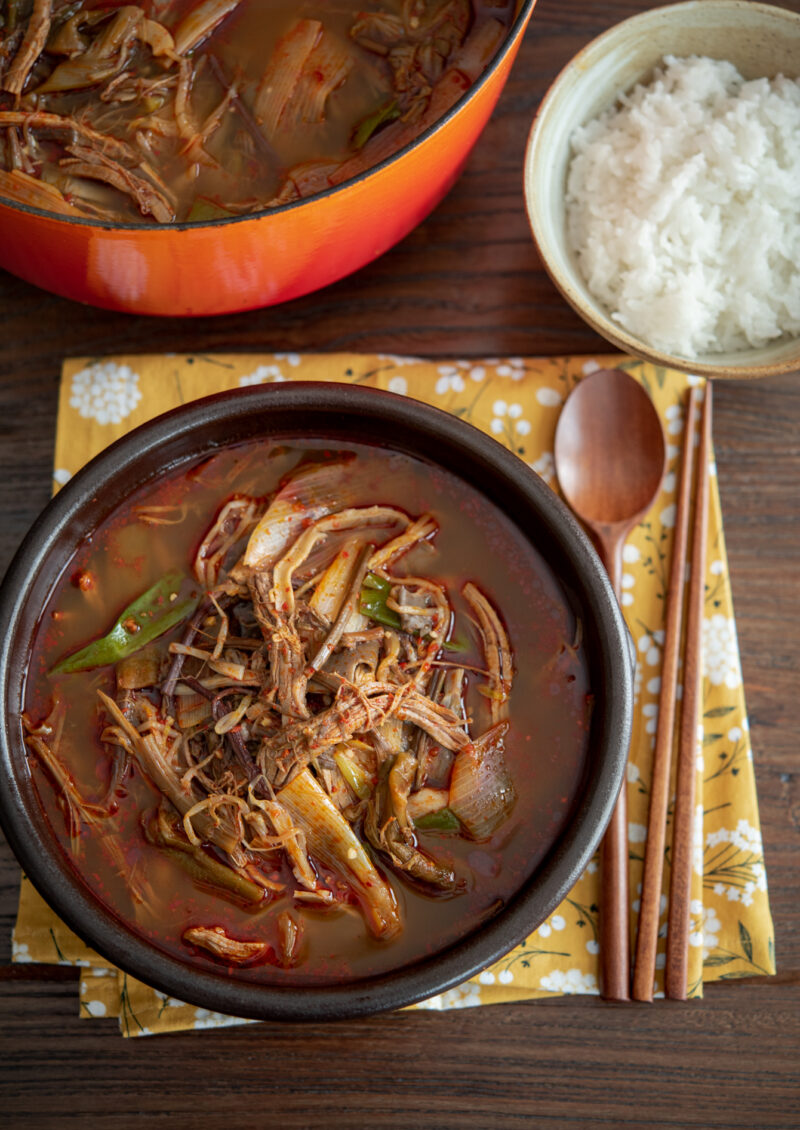

If you love beef soup with a spicy kick, don’t miss Yukgaejang (육개장), a hearty Korean spicy beef vegetable soup. Packed with shredded beef and a variety of vegetables, this soup is rich in flavor and sure to satisfy once you try it.
Making authentic Korean beef soup isn’t difficult, but it does take time. To get that deep, savory flavor, you need to simmer beef brisket with onion, garlic, and radish to create a rich broth, then shred the meat. Dried vegetables like fernbrake (gosari) and taro stem (toran) are rehydrated, while fresh veggies add extra texture.
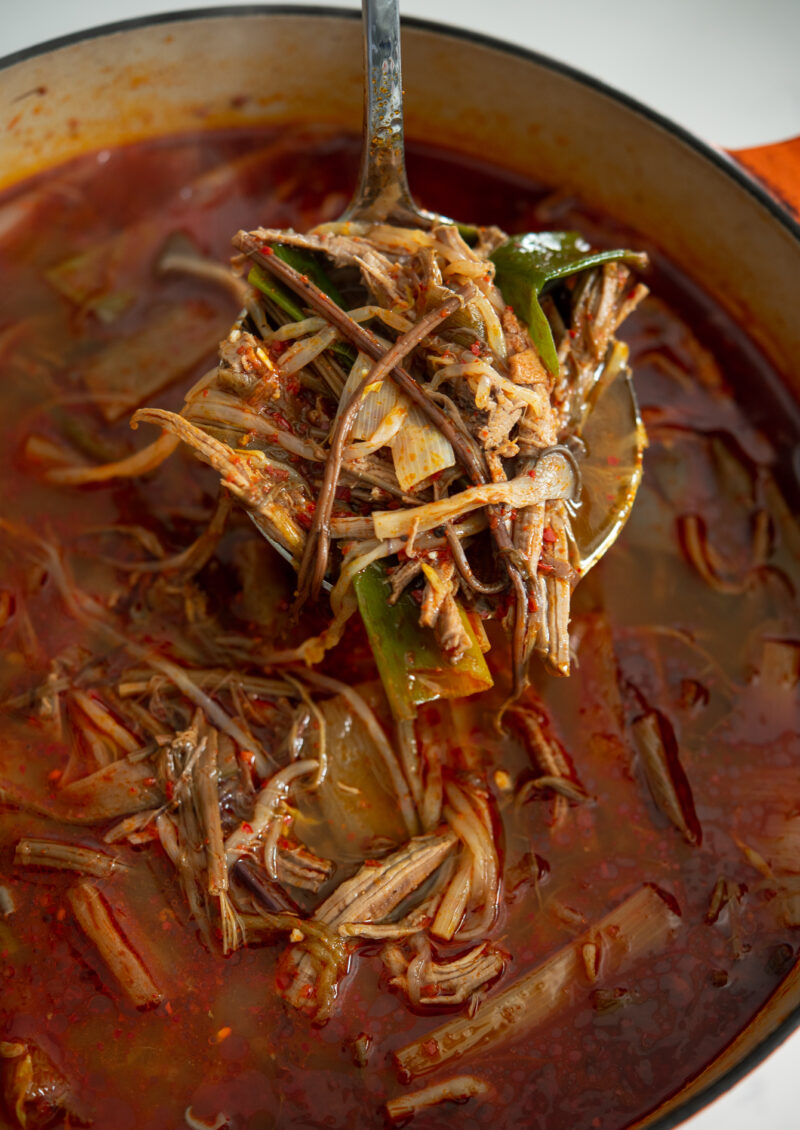

While this isn’t a quick recipe, it’s not as complicated as it may seem. Just follow the four key steps I’ll outline below, and you’ll be on your way to a perfect Yukgaejang.
The effort is worth it, and this recipe makes a large batch, so you can enjoy it for days—some even say it tastes better on day 2 or 3. If you’re craving traditional Korean flavors, this is the soup for you. For a chicken version, try my Dakgaejang recipethe spicy chicken soup.
4 Essential Steps Before Making Yukgaejang
- Preparing Dried Vegetables: Boil dried fernbrake (bracken fiddlehead) and taro stem, then soak them in hot water for 1 hour to fully rehydrate.
- Making the Beef Stock: Simmer beef brisket, onion, whole garlic, and radish for 45 minutes to create a rich, flavorful stock.
- Blanching Fresh Vegetables: Parboil mung bean sprouts, mushrooms, and Asian leeks in boiling water for 60 seconds to remove any bitterness and sliminess.
- Preparing Chili Oil: Gently heat oil with Korean chili flakes (gochugaru) over low heat to release flavor, then toss the vegetables and beef in the chili oil before starting the soup.
Once you’ve completed these 4 essential prep steps, the actual cooking only takes about 20 minutes of simmering. Not too bad, right?
Dried vegetables in spicy Korean beef soup
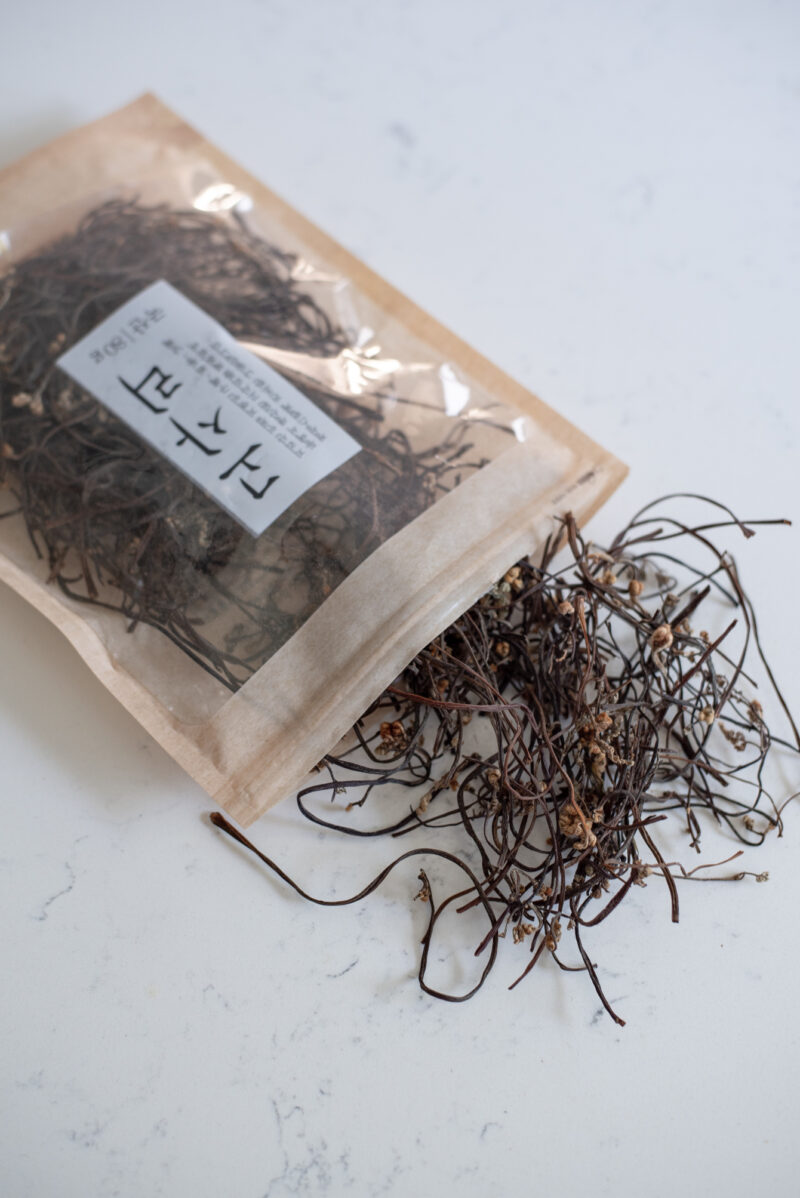

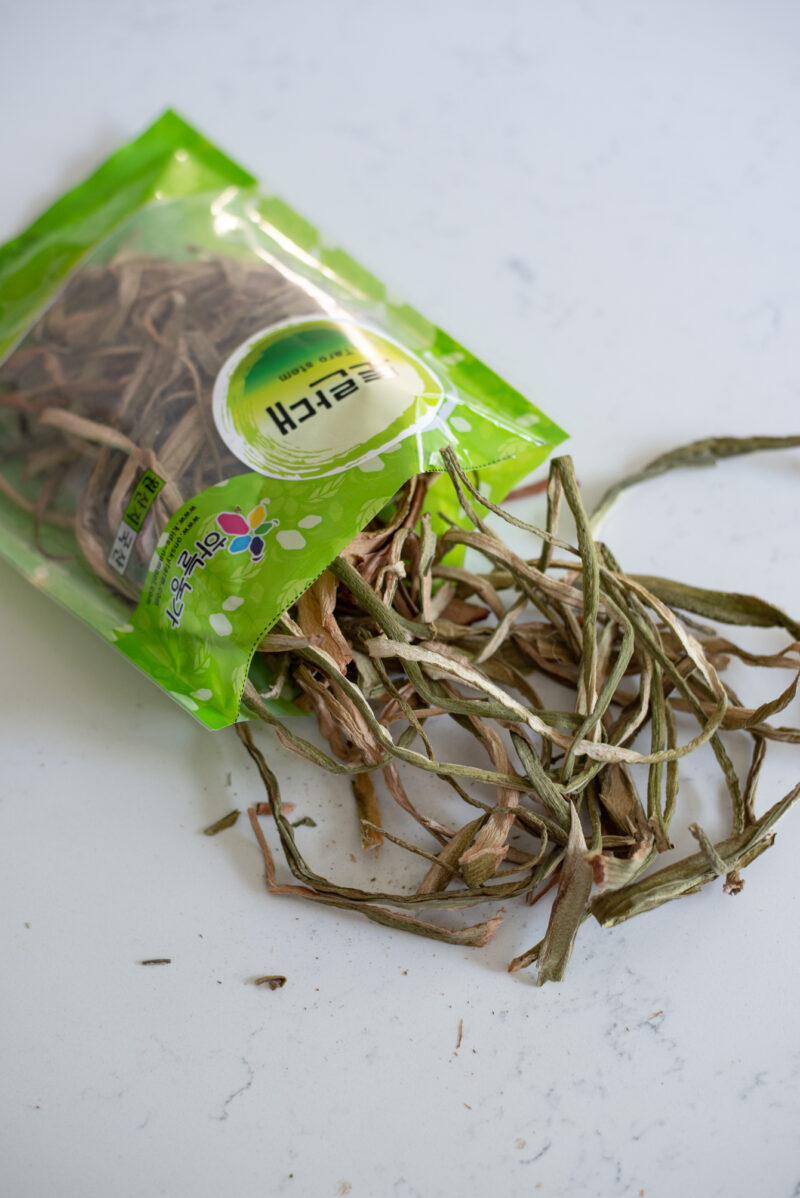

Dried fernbrake (gosari, 고사리) and taro stem (toran, 토란) are easily found in many Korean stores. They have a feather-light weight since they are dried. You only need about half bag of each for this recipe.
In order to re-hydrate, follow these steps. They will quadruple in volume once fully re-hydrated and cooked.
If dried vegetables are hard to find, you can substitute shiitake mushrooms for fernbrake and use extra leeks and mung bean sprouts in place of taro stem.
How to re-hydrate the dried vegetables
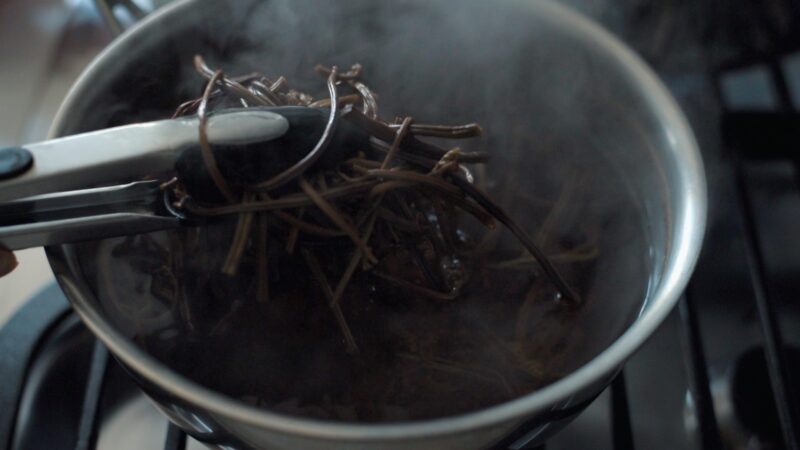

Add a desired amount of ferrnbrake in a pot filled with water. Bring to boil, then simmer for 20 minutes, covered. Remove the pot from heat and let fernbrake soak in the pot for 1 hour, covered.
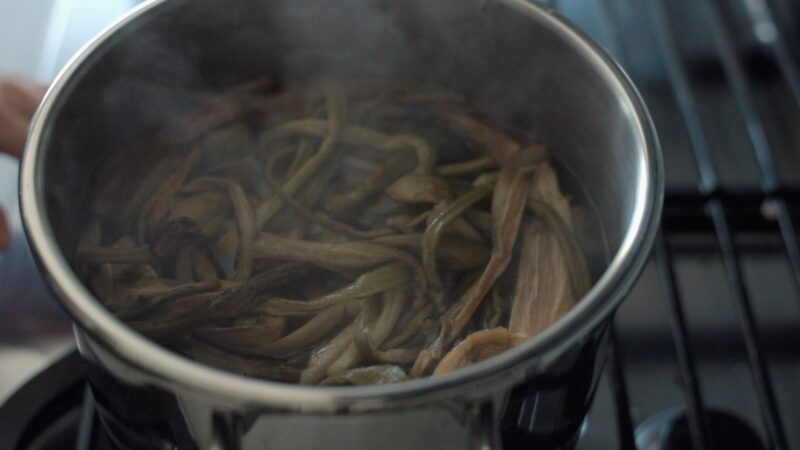

In another pot, cook the taro stem using the same method. Let it soak in the pot for 1 hour as well.
Drain the dried vegetables and rinse them in cold water several times. Squeeze out the extra water from the vegetables.
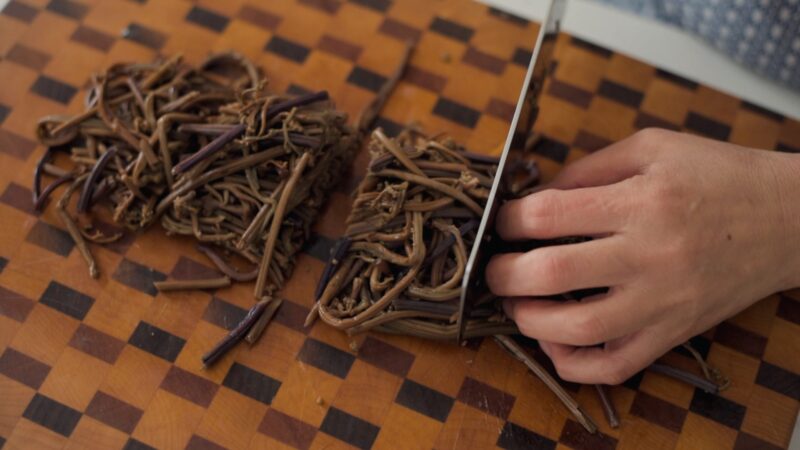

Cut fernbrake and taro stem in 2-inch slices.
How to make Korean Beef Vegetable Soup
Make beef stock
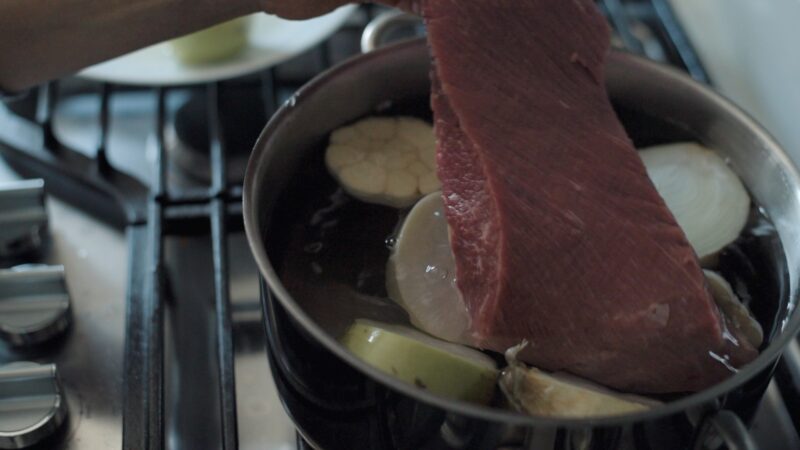

In a stock pot, add onion, halved garlic, radish chunks, and beef brisket. Pour in 14 cups of water and bring to a gentle boil over medium-high heat. Lower the heat and simmer for 45 minutes.
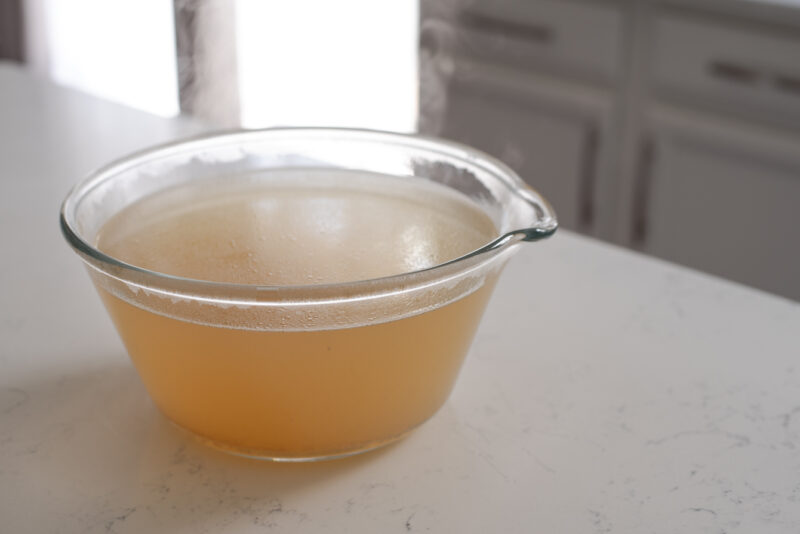

Remove the vegetables and set the beef aside. Strain the broth through a skimmer to catch any small particles, then set the broth aside.
Blanch fresh vegetables
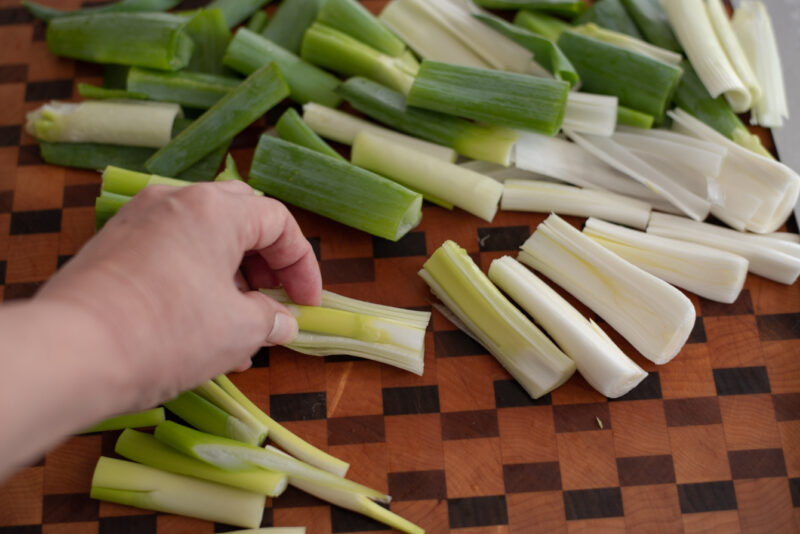

Cut the Asian leeks in half lengthwise, then into 2-inch slices. Optionally, remove the tough pale green core from the white parts, or leave it as is.
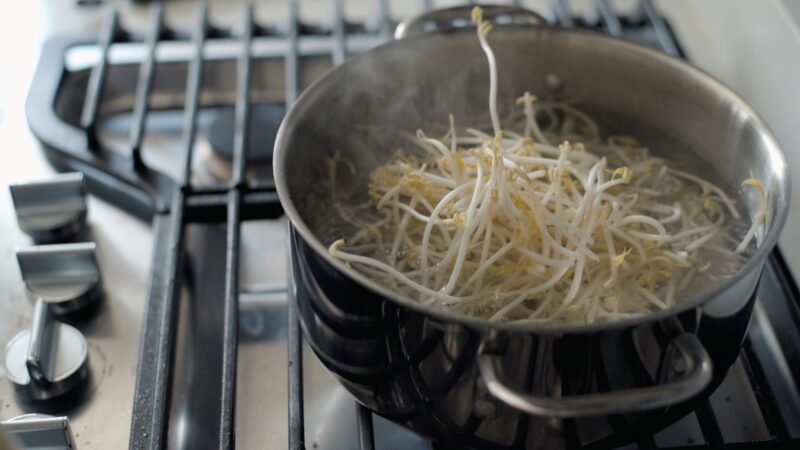

Add mung bean sprouts to a large pot of boiling water, give them a stir, and blanch for 10 seconds.
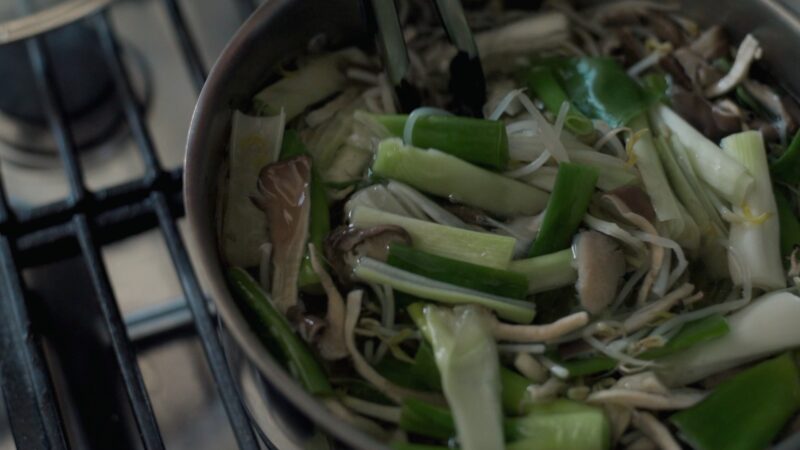

Add the oyster mushrooms and leek slices, cooking for an additional 10 seconds. Drain and rinse the vegetables under cold water, then squeeze out any excess water.
Shred beef
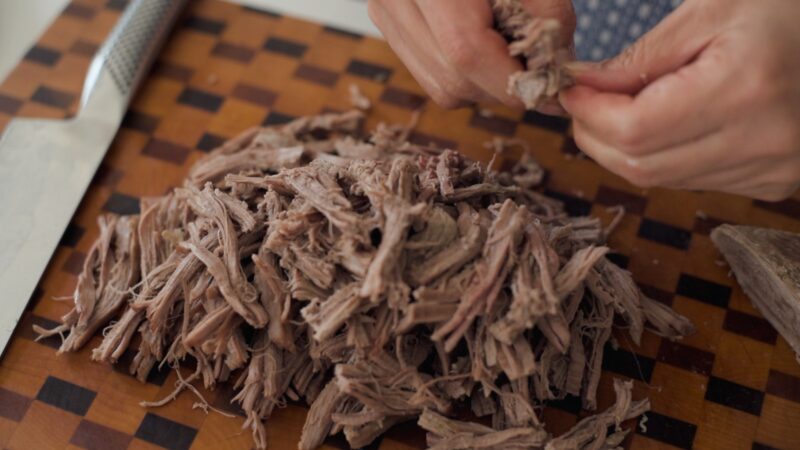

Once the beef is cool enough to handle, shred it into bite-sized pieces.
Make a soup with beef and vegetables
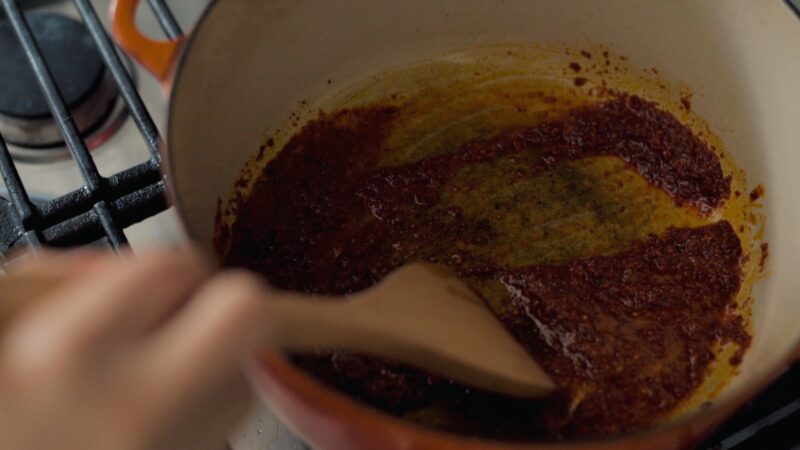

In a large pot, heat oil and sesame oil over low heat. Stir in the Korean red chili pepper flakes (gochugaru) for 30 seconds to release their fragrance and infuse the oils.
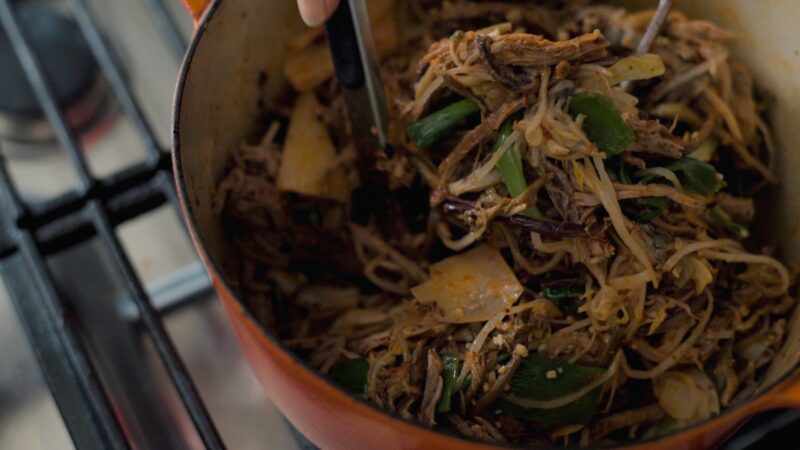

Add the vegetables and beef to the pot, stirring well to coat them evenly in the chili oil.
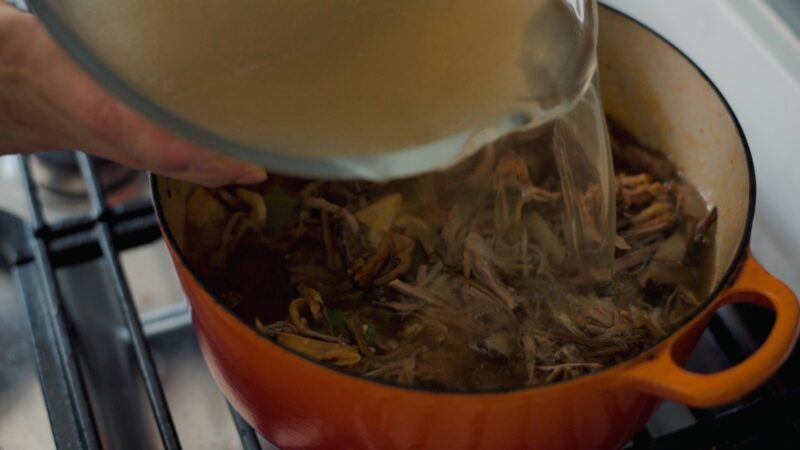

Pour the reserved stock into the pot, using 8 to 10 cups depending on how thick or thin you prefer your stew.
Add flavors
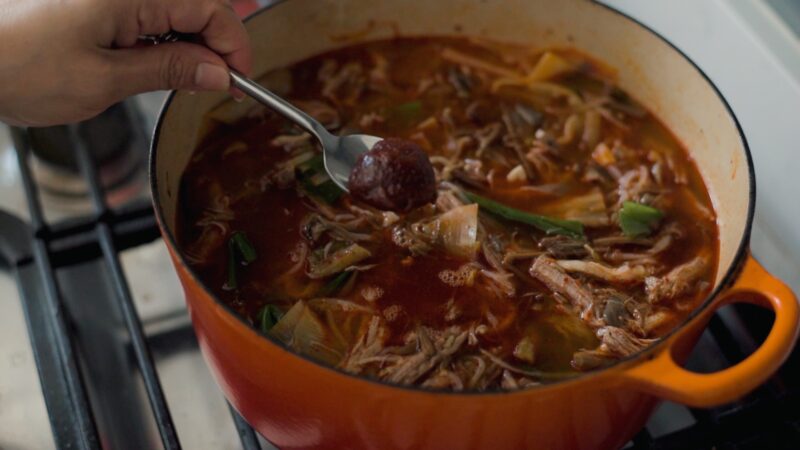

Stir in a teaspoon of Korean chili paste (gochujang) to keep the broth vibrant. Cover and simmer the stew over medium-low heat for 15-20 minutes.
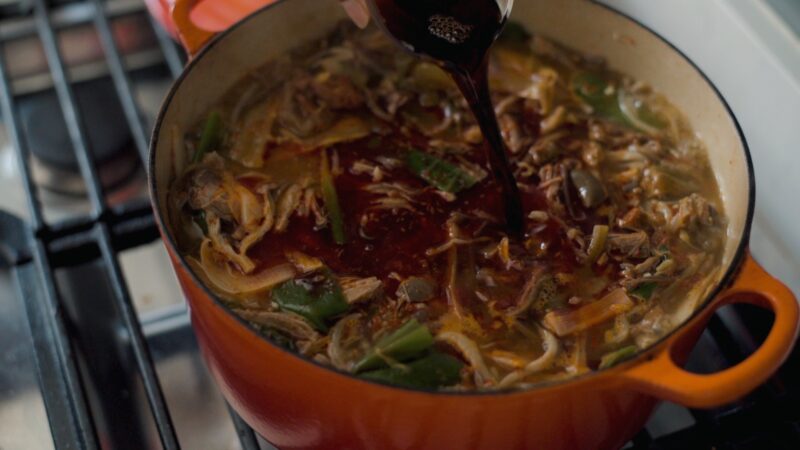

Season the stew with a mix of soy sauce, Korean soup soy sauce, and Korean anchovy sauce.
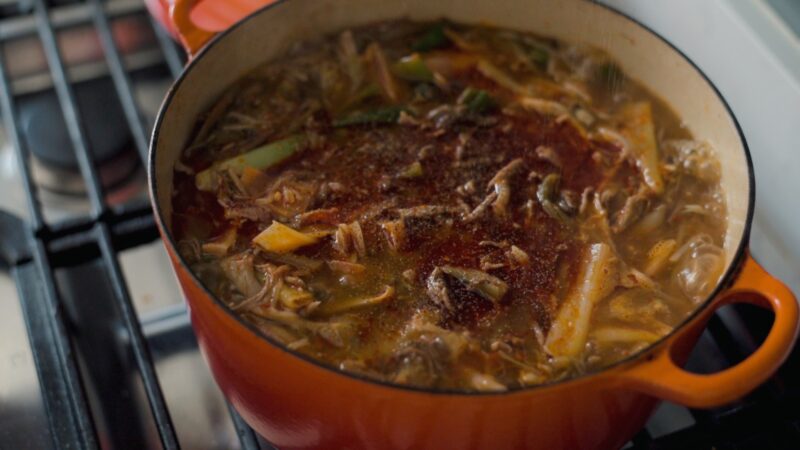

Taste the broth and add salt if needed. Finish with plenty of black pepper to your liking. Serve Yukgaejang hot with a bowl of rice and a simple kimchi. You can sprinkle more black pepper according to your taste.
Storage Tip
You are making a big batch of stew to last for another meal. In fact, the flavor will deepens on the next day. Store any leftovers in the refrigerator up to 1 week. You can also freeze the stew up to 3 months.
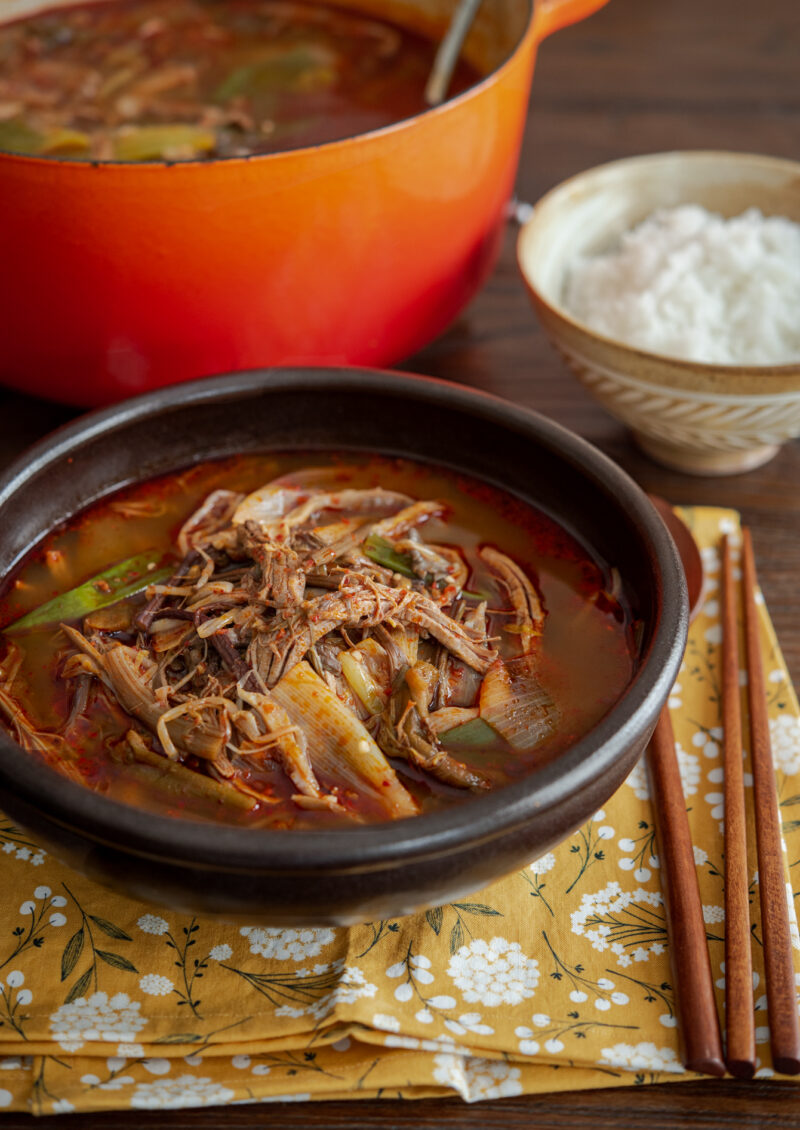

This recipe was originally posted in December 2012. I’ve updated the recipe with a few changes, new photos, and more information.
More Korean Soups
Soups bring a comfort to our body and mind. Here are a few that I love and I hope you will love, too.
Love this recipe? Rate it and share your experience in the comments below! On Instagram? Tag me to showcase your creation. For more delicious recipes, subscribe to our newsletter!
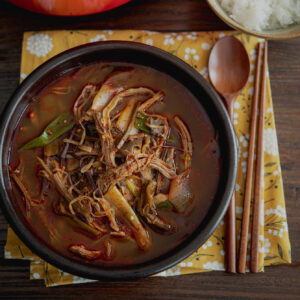

Korean Spicy Beef Vegetable Soup (Yukgaejang)
Yukgaejang is a flavorful Korean spicy beef and vegetable soup, packed with shredded beef and hearty vegetables. This classic Korean soup is perfect for cold days, offering a comforting, spicy kick.
For beef stock
- 1 1/4 lb beef brisket
- 1 large onion , cut in half
- 1 whole garlic , cut in half
- 1/2 lb Korean radish, cut into large chunks
- 14 cups water
To re-hydrate the dried vegetables
-
Add fernbrake in a pot filled with water. Bring it to a gentle boil and simmer for 20 minutes. In another pot, cook the taro stem using the same method. Let it soak in the pot for 1 hour as well. Remove each pot from the heat and let vegetables to soak in the pot, covered, for 1 hour.
-
Drain the dried vegetables and rinse them in cold water several times. Squeeze out the extra water from the vegetables. Cut fernbrake and taro stem in 2-inch slices.
To make the beef stock
-
In a stock pot, combine onion, whole garlic (cut in half), chunks of radish and beef brisket. Add 14 cups of water to the pot and bring it to a gentle boil. Reduce the heat to low and let it simmer for 45 minutes.
-
Discard the vegetables and reserve the beef. Strain the stock in a skimmer to collect any small particles. Reserve the stock.
-
When the beef is cooled to touch, shred the beef into bite size pieces.
To blanch the fresh vegetables
-
For the Asian leeks, cut them in half lengthwise, then cut into 2-inch slices. As an optional step, remove the pale green core in the center of the white parts of the leeks because they tend to be tough. You can leave it the way it is, if you wish.
-
Bring a large pot of water to boil and sprinkle some salt. Add mungbean sprouts, stir, and wait for 10 seconds.
-
Add oyster mushroom and leek slices. Cook the vegetables for 10 more seconds. Drain and rinse the vegetables in cold running water. Squeeze out the extra water.
To make the beef soup (Yukgaejang)
-
Heat oil and sesame oil in a large pot over low heat. Add the Korean chili flakes and stir it for 30 seconds to release the fragrance and infuse the oils.
-
Add the vegetables and beef into the pot. Stir well to coat them with the chili oil. Pour the reserved stock into the pot. The amount of stock could be between 8-10 cups, depending on how thin you want your stew to be.
-
Add a teaspoon of Korean chili paste (gochujang) into the stew and mix well. Chili paste will help your stew to maintain its redness of broth without going dull. Cover the pot and let the stew simmer for 15-20 minutes over med-low heat.
-
Season the stew with 3 different Korean sauces; soy sauce, Korean soup soy sauce, and Korean anchovy sauce. Taste the broth and add some salt, if needed. Lastly sprinkle with lots of black pepper according to your taste.

